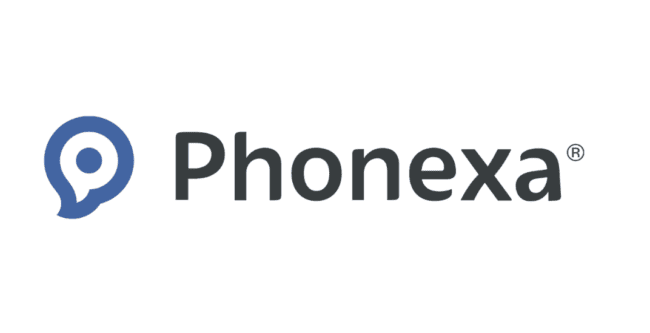How to Use Semrush to Find New Affiliate Partnerships
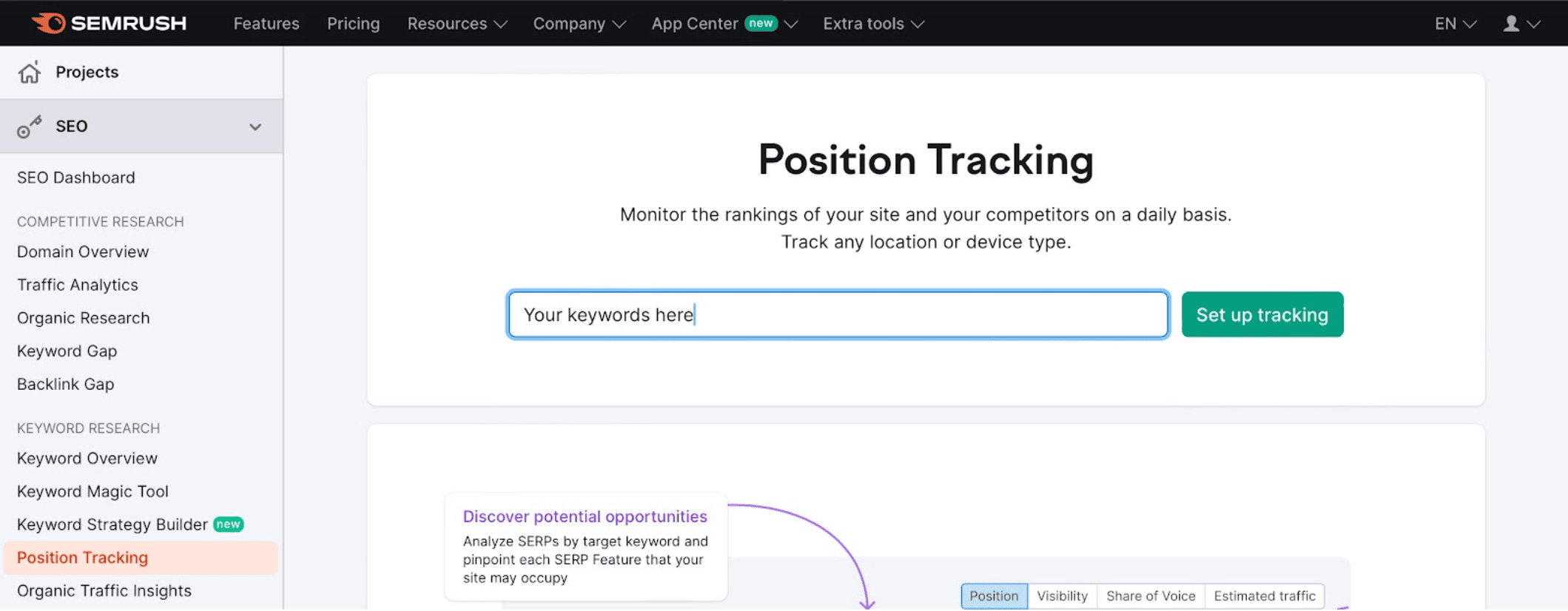
Affiliate marketing has long since been a powerful way to generate revenue promoting other companies’ products or services. However, finding the right affiliates to promote your products and services can be challenging. Semrush, a comprehensive digital marketing tool, can simplify this process and help you narrow the search for affiliates that convert well with your products and services.
This in-depth guide will walk you through how to use Semrush’s intuitive analytics and data segments to identify and secure the right partnerships and identify competitive analysis to help you discover new affiliates to work with.
What is Semrush?
Semrush is an all-in-one digital marketing suite that offers tools for SEO, content marketing, competitor analysis, PPC, and social media. The tool is used by affiliates to find insights and opportunities to grow their traffic and is also used by affiliate program managers to measure and monitor what traffic is going to their competitors and helps them find new affiliate partners and traffic sources to invite into their affiliate programs.
Semrush offers valuable insights that can help you identify potential new affiliate partner sites driving traffic based on top keywords that are related to your own product or service and enables marketers to analyse their performance, and optimise their affiliate marketing strategy through in depth reports and data that is collected and displayed within the Semrush dashboard.
Setting Up Your Semrush Account
Before diving into the tools and discovering what you can learn and utilise to improve your own affiliate program, you will need to set up your own personal Semrush account:
- Sign Up: Visit the Semrush website and sign up for an account. You can start with a free trial to explore these features before you upgrade to a paid version.
- Choose a Plan: Depending on your needs, select the user guide plan that suits your business. Semrush offers various plans with different features which you can read about further here.
- Set Up Your Profile: Complete your profile by adding your website and other relevant information.
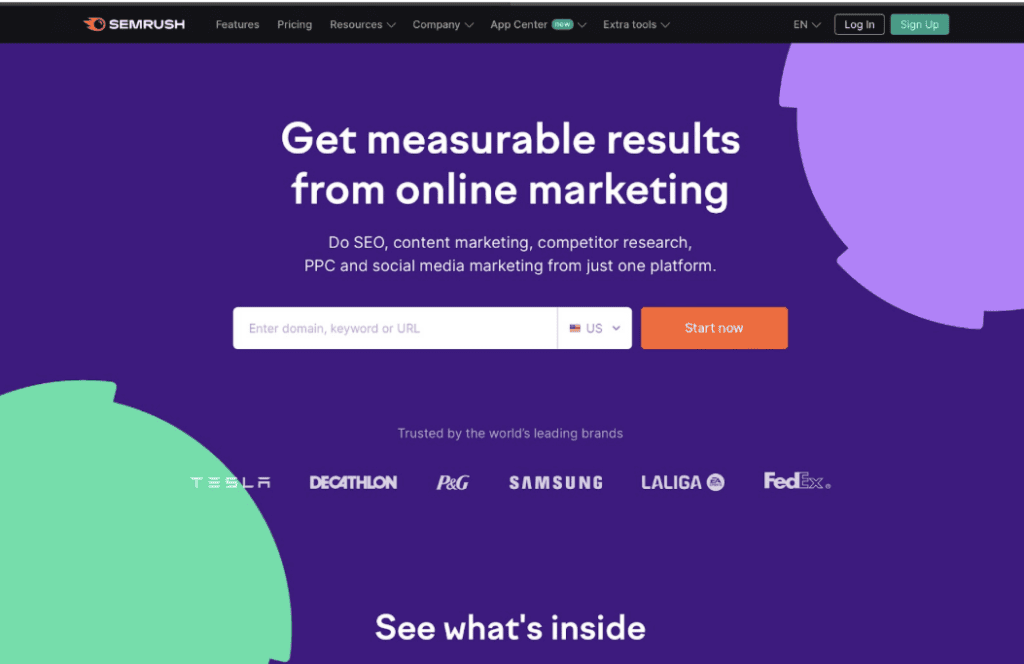
Understanding Semrush Tools for Affiliate Marketing
Semrush offers several tools that are particularly useful for affiliate marketing:
- Keyword Research: Identify high-performing keywords related to your products, services and niche interests.
- Competitor Analysis: Analyse your competitors’ affiliate strategies and inbound traffic sources
- Backlink Analysis: Discover potential partners by analysing your competitor’s backlinks.
- Content Marketing: Find content opportunities to attract potential partners and partners already targeting these topics to attract them to your program.
- Market Explorer: Understand your market and identify key players and referring URLs that can help you find new partnerships outside of your own affiliate program or affiliate network.
Identifying Potential Affiliate Partners
Keyword Research
Start by identifying keywords related to your niche. Use the Keyword Magic Tool to find high-volume, low-competition keywords. This will help you understand what your target audience is searching for and identify potential partners who rank for these keywords. Once you’ve discovered who these are you can create an outbound outreach strategy to invite these sites to join your affiliate program and begin negotiating new partnerships for exposure on their sites and databases (e-mails, social media, community chats etc.)
It’s really simple and easy to begin – follow these steps and build your research list which will then help you identify traffic sources later on.
- Access Keyword Magic Tool: Go to the Semrush dashboard and select the Keyword Magic Tool.
- Enter Keywords: Enter keywords related to your niche.
- Analyse Results: Look for keywords with high search volume and low competition.
- Identify Websites: Note down websites that rank for these keywords. These could be potential affiliate partners.
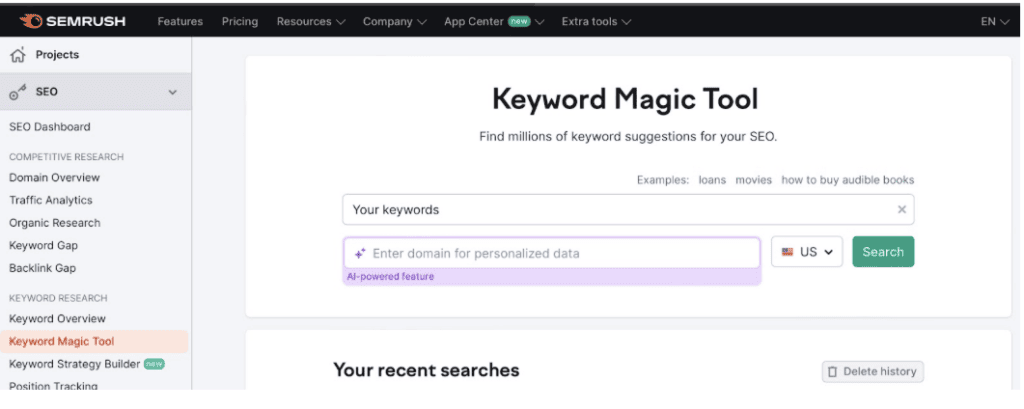
Backlink Analysis
Backlink analysis helps you find websites that link to your competitors. These websites are likely already referring traffic to your competitors in some way or another. Building this list enables you to identify potential affiliate partnerships which you can then leverage and contact to promote your own opportunities and build a partnership that can help your business grow. Understanding where your competitors are leveraging traffic into their site can help you identify and target potential new partners to work with that perhaps fall outside of the traditional affiliate network you may be invested in and offer new opportunities for growth in the short term.
To access this information simply follow these steps:
- Access Backlink Analytics: Go to the Backlink Analytics tool.
- Enter Competitor URL: Enter the URL of a competitor.
- Analyse Backlinks: Look at the websites that link to your competitor.
- Identify Potential Partners: Note down websites that could be potential partners.
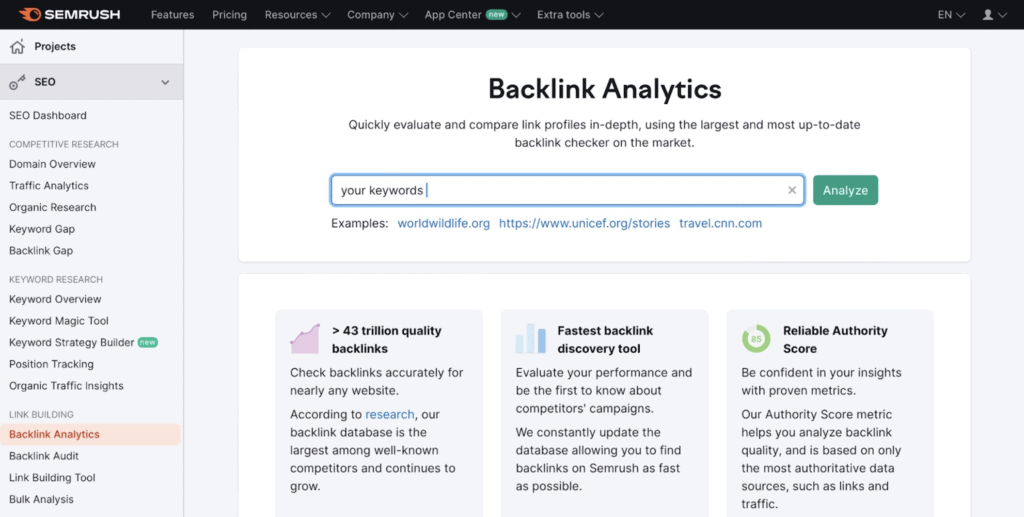
Analysing Competitors’ Affiliate Strategies
Understanding your competitors’ affiliate strategies can give you a competitive edge over how much to invest in certain categories or traffic sources. You’ll be able to see how your competitors are segmenting their affiliate program and what kinds of referring partners are driving volumes of visits to your competitor’s site.
Once you know who these partners and website referrers are – you can go deeper and investigate the placement and type of partners these sources are and why your competitor may be finding these relationships useful. The insights alone on how you can benchmark your program to that of your nearest competitor can provide compelling insights that help you change your strategy to align with the wider marketplace as a whole.
Use the following tools to analyse your competitor’s inbound traffic strategies:
Traffic Analytics
Traffic Analytics provides insights into your competitors’ traffic sources, audience behaviour, and top-performing pages. Why is this important? You’ll be able to understand not only what site or partner your competitors are relying on for inbound traffic but also what page and placement is valuable within the affiliate’s website. Whilst it’s important to be visible with top performing partners, it’s also important to understand exactly where that visibility can be leveraged as it impacts your commercial pricing for that placement.
Many affiliate managers will always want to be on the homepage of an affiliates site, but often – when you have access to the data that Semrush can provide – you may find specific review pages or deep link pages in an affiliates site are the best places to be visible and these subsequent pages could come at a cheaper price than the assumed – best placement of the traditional home page.
Understanding the analytics that Semrush offers can help you increase your profit margins when negotiating deals with affiliates who have organic SEO pages that can sometimes rank higher than their home page for a particular subject or product as an example.
Ready to dive into the traffic of your competitors? Follow these simple steps:
- Access Traffic Analytics: Go to the Traffic Analytics tool.
- Enter Competitor URL: Enter the URL of a competitor.
- Analyse Traffic Sources: Look at where their traffic is coming from.
- Identify Top Pages: Note down their top-performing pages and the sources driving traffic to these pages.

Affiliate Research
Semrush’s Affiliate Research tool helps you identify the affiliate programs your competitors are part of. Why is this interesting to look at?
Two key reasons as explained below:
Firstly – when you look at the affiliates who are also working with your competitors you can understand if there is a reason to invest more time to gain more market share of their traffic or – if you can’t actively compete with these brands to win market share -you can focus your attention and efforts on finding new partners that don’t have relationships with your competitors and nurture these relationships instead.
Secondly, you can also take a look at where your competitors are investing their effort to ask the question WHY. Is it because these are legacy partners who have grown over time, or are they taking a tactical approach to double down in a certain traffic segment because they are seeing good value and customer conversion in it. Does this then open a path for you to attack and conquer or diversify and segment in your own affiliate program strategy. It’s really important to understand the landscape in which you are competing to build a growth plan that maximises your budget and resourcing.
Here’s the steps to follow if you want to delve deeper into Affiliate Research
- Access Affiliate Research: Go to the Affiliate Research tool.
- Enter Competitor URL: Enter the URL you want to discover and research
- Analyse Affiliate Programs: Look at the affiliate programs they are part of.
- Identify Potential Programs: Note down programs that are showing and go investigate them further. This also allows you to do some competitive benchmarking as you can look at how their commercials, terms and incentives are structured to benchmark against them as well.
** Plus – if you’re an affiliate reading this – use this tool to look at where your nearest affiliate competitors are sending their traffic to find the right programs and suppliers to promote (if nothing else it may give you some competitive insights on where and how to focus your relationship building efforts to gain momentum against your competitors too!)
Evaluating Potential Partners
Once you have a list of potential partners, evaluate them to ensure they are a good fit for your affiliate program. Getting the list is part of the process. Now you need to identify all the potential partners you want to invest your time, energy and money into outreach, onboard and connect and engage with them.
Using Semrush’s domain analysis tool – you can quickly shorten the list down to a manageable level and start to hone in on the partners that can really add value to your existing program taking a closer look at placement , position and opportunities that match your own program KPI’s and marketing expansion goals.
This tool helps you identify if the affiliate in your research list definitely has the right customer avatar profile and then also how you can position your sales and outreach efforts to hit the interest points that are relevant to them to engage them and onboard them into your affiliate program.
Domain Analysis
Use the Domain Overview tool to analyse the potential partner’s domain, traffic, user insights and more.
- Access Domain Overview: Go to the Domain Overview tool.
- Enter Domain: Enter the domain of the potential partner.
- Analyse Metrics: Look at metrics such as domain authority, organic traffic, and backlink profile.
- Evaluate Fit: Ensure the partner has a strong online presence and aligns with your brand values.

Content Analysis
Analyse the content of potential partners to ensure it aligns with your brand and audience. It’s one thing to look over what affiliates your competitors are working with, but quite another to evaluate if they are automatically the right partners for you to work with too. Every business has different risk profiling. What’s good for your competitor may not stack up and be as good for you. From branding to messaging and design – all of these factors need to be considered when doing affiliate benchmarking and program research.
Use the content analysis tool to have a look at the value of the content these partners are creating and if that aligns to your own brand and tone of voice. Remember affiliates are the first touch points your new customers may be experiencing before they purchase on your site, so make sure you work with partners who know how to present products and services professionally and can align to your own brand guide, quality and content guidelines too.
Follow these steps to delve a bit deeper into the Content Analysis tool that Semrush offers, and discover if the partners you’ve identified really are the ones you want to invest time in to onboard to your affiliate program :
- Access Content Analyzer: Go to the Content Analyzer tool.
- Enter Domain: Enter the domain of the potential partner.
- Analyse Content: Look at the type of content they produce and its engagement metrics on this content. Assess whether it is good enough quality and if your customers would align and engage with it. Also look at whether they are promoting your competitors in the best light and with the right level of detail and professionalism.
- Evaluate Fit: Ensure the content is relevant to your audience and of high quality because if you engage this partner – will they create the same level and depth of insights for your products or services too?
Reaching Out to Potential New Affiliate Partners
Once you have identified and evaluated potential partners, it’s time to reach out to them. Time to use that data you’ve been researching to hyper personalise the content you send out to these new targeted affiliates.
The time for sending cold call outreach emails to affiliates you really want to engage and work with is over. The data that Semrush has provided in the checkpoints we’ve outlined above means you can include this in your messaging to hyper personalise the content you send.
First impressions count in this business and if you’re in a highly competitive market, you can use this data to really make a great first impression with the affiliate partner you’re trying to recruit. Tell them why you think you’d work well together, list out the exact placements that you want to talk about within their page portfolio. Show them that you’ve taken the time to research their business and that you understand how your offer can help them grow their earnings.
Your pitch should be personalised and highlight the benefits of partnering with you – which you’d now have at your fingertips after completing the steps above.
Remember to keep your outreach messaging brief. Affiliates are busy entrepreneurs – so follow these simple steps to craft that perfect proposal:
- Personalise Your Message: Address the potential partner by name and mention specific details about their website or content.
- Highlight Benefits: Explain how the partnership will benefit them, such as increased traffic or revenue.
- Provide Examples: Share examples of successful partnerships you have had in the past.
Contacting Potential Partners using Semrush built in CRM functions
If you’re on a paid membership to the platform, you can simply opt in to use the built in CRM tool to manage your outreach efforts after your research is complete.
- Access CRM Tool: Go to the CRM tool.
- Add Contacts: Add the contact details of potential partners.
- Track Outreach: Keep track of your outreach efforts and follow up as needed within the platform.
Tracking and Optimising Your Affiliate Partnerships
Once you have established affiliate connections and invited these partners to join your affiliate program, it’s important to keep track of them so that you can further optimise the campaigns and budgets you’re allocating to them. Remember in affiliate marketing – it’s never a once and done relationship. Traffic sources change, rankings are impacted, and pricing for demand and supply increases or decreases constantly affect the result of your affiliate relationships. That’s why it’s important to have a clear understanding of when and where changes to your supply of traffic are changing within your affiliate program month to month.
Tracking Performance
Use Semrush’s tracking tools to monitor the performance of your affiliate partnerships. Follow these simple steps to perform a quick audit on what’s changing and what’s an opportunity to explore further to keep your ROI on commercial deals and New customers sales optimised.
- Access Position Tracking: Go to the Position Tracking tool.
- Enter Keywords: Enter the keywords related to your affiliate partnerships.
- Monitor Rankings: Keep track of how your partners’ content is ranking for these keywords.
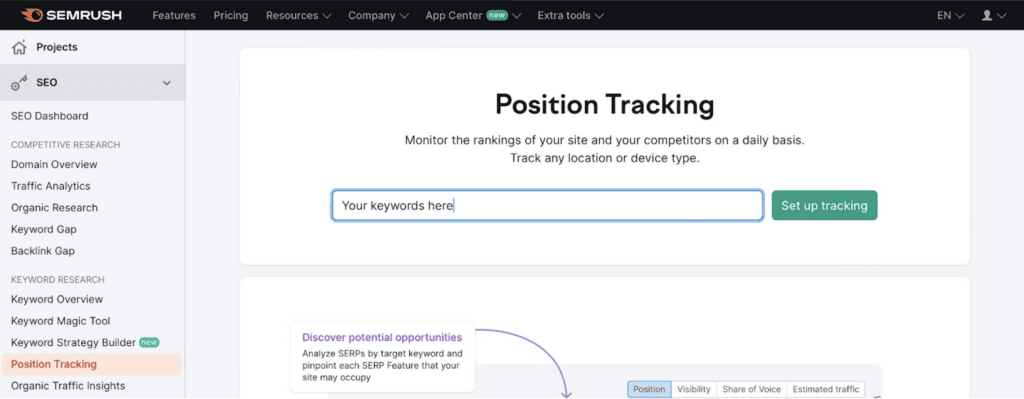
Optimising Partnerships
Regularly review and optimise your affiliate partnerships to ensure they are performing well.
- Analyse Performance: Use Semrush’s analytics tools to analyse the performance of your partnerships.
- Identify Opportunities: Look at what the data shows you and leverage that for opportunities to improve, such as optimising your offer content or targeting new keywords that customers may be looking at on your affiliate’s website traffic analysis. You may discover new niches before your competitors do and can jump into analysing that for new potential partners too.
- Communicate with Partners: Regularly communicate with your partners to discuss performance and potential improvements leveraging the data that the Analytics tools provide. It’s important to provide your affiliates with feedback on how the data is changing and how they can optimise their campaigns with you to continue earning better commissions and driving more sales.
Whether you’re an affiliate or an affiliate manager, Semrush provides an entire ecosystem of support tools designed to help you assess the market, review your competitors and get structured in the way you seek out new affiliate opportunities that are matched exactly to your own specific criteria.
Semrush is a powerful tool that can help you find and secure new affiliate partnerships. By leveraging its comprehensive suite of tools they provide as described above you can easily identify potential partners, analyse their performance, and optimise your affiliate marketing strategy to create incremental growth outside of your regular affiliate network marketplace.
Get a FREE trial Analyse Market Trends and make the most of Semrush to grow your affiliate program today.
Disclaimer: This article may contain affiliate links, which means we may earn a commission if you make a purchase through these links.
The commissions earned help support our website development and content production helping you to keep learning more about Affiliate Marketing and Program Management. We only promote products or services that we have personally used or believe will add value to our audience. Our reviews and recommendations are based on honest opinions and our own user experiences. Please be aware that by clicking on an affiliate link and making a purchase, you may be redirected to the respective merchant’s website, and they may have their own terms and privacy policies. We encourage you to review those policies before making a purchase.



